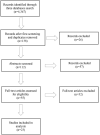Creative Collaboration and Collaborative Creativity: A Systematic Literature Review
- PMID: 34434151
- PMCID: PMC8380918
- DOI: 10.3389/fpsyg.2021.713445
Creative Collaboration and Collaborative Creativity: A Systematic Literature Review
Abstract
Studies of creativity emerging from cultural psychology and social psychology perspectives challenge individualist conceptions of creativity to argue that social interaction, communication, and collaboration are key elements in creativity. In recent work creative collaboration has been proposed to be "distributed" between audiences, materials, embodied actions, and the historico-socio-cultural affordances of the creative activity and environment, thus expanding the potentialities of creative collaboration beyond instances of direct human interaction and engagement. Music performance, improvisation and composition may be viewed as exemplary "laboratories" of creative collaboration through the combined elements of audiences, materials, embodied actions and historico-socio-cultural affordances and constraints. This article reports the findings of a systematic literature review of creative collaboration and collaborative creativity in music. We sought to identify what has been currently investigated in relation to these terms and concepts in music, with what methodologies and in what settings. Findings indicate that studies were undertaken in higher education, professional development and professional practice predominantly, leading to an emergent phenomenon of interest, collaborative creative learning. Musical genres were jazz, popular, western classical, contemporary and world musics across the musical processes of composing, improvising and performing. Studies in higher education and professional development settings focused on identifying those practices that supported learning rather than the nature of collaborative creative approaches or the outcomes of creative collaboration. Participants were primarily male, with small sample sizes. Methodologies were largely qualitative with an emphasis on case study using observation, interview and reflective diary methods. Further areas for research include: the investigation of gendered approaches to creative collaboration, collaborative creativity, and collaborative creative learning; the use of more diverse research methodologies and methods and techniques including large-scale quantitative studies and arts-based and arts-led approaches; and the investigation of more diverse music settings.
Keywords: collaborative creative learning; collaborative creativity; composition; creative collaboration; cultural psychology; distributed creativity; improvisation; music performance.
Copyright © 2021 Barrett, Creech and Zhukov.
Conflict of interest statement
The authors declare that the research was conducted in the absence of any commercial or financial relationships that could be construed as a potential conflict of interest.
Figures
References
-
- Amabile T. (1983). The Social Psychology of Creativity. New York, NY: Springer Verlag.
-
- Barrett M. (2006). “Creative collaboration”: an “eminence” study of teaching and learning in music composition. Psychol. Music 34, 195–218. 10.1177/0305735606061852 - DOI
-
- Barrett M. S., Ford A., Murphy P., Pollett P., Sellars E., Viney L. (2014). The scattering of light: shared insights into the collaborative and creative processes that underpin the development and performance of a commissioned work, in Collaborative Creative Thought and Practice in Music, ed Barrett M. S. (Surrey: Ashgate Publishing limited; ), 17–31.
-
- Barrett M. S., Gromko J. E. (2007). Provoking the muse: a case study of teaching and learning in music composition. Psychol. Music 35, 213–230. 10.1177/0305735607070305 - DOI
-
- Bayley A., Lizée N. (2016). Creativity layers and continuities: a case study of Nicole Lizée and the Kronos Quartet. Music. Sci. 20, 393–412. 10.1177/1029864916631917 - DOI
Publication types
LinkOut - more resources
Full Text Sources


